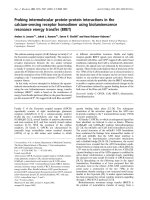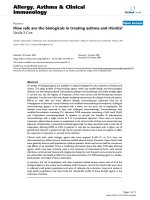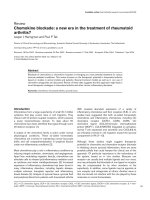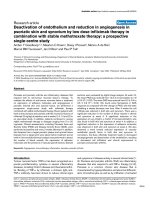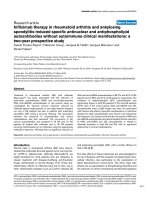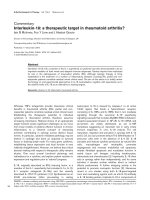Báo cáo y học: "Hyperinsulinemia-euglycemia therapy: a useful tool in treating calcium channel blocker poisoning" pps
Bạn đang xem bản rút gọn của tài liệu. Xem và tải ngay bản đầy đủ của tài liệu tại đây (29.15 KB, 2 trang )
Page 1 of 2
(page number not for citation purposes)
Available online />Abstract
Hyperinsulinemia-euglycemia (HIE) therapy, when initiated promptly
and aggressively, may offer considerable advantages in the treat-
ment of calcium channel blocker poisoning. Although its
mechanism of action is uncertain, HIE improves the efficiency with
which the poisoned myocardium uses metabolic fuel, the end
result of which is improvements in inotropy and other cardio-
vascular parameters. Although HIE is not universally accepted, the
reports included in the previous issue of Critical Care should
prompt clinicians to consider HIE an appropriate therapy
specifically for calcium channel blocker poisoning.
Interest in a bizarre treatment for calcium channel blocker
poisoning, namely hyperinsulinemia-euglycemia (HIE), continues
to grow. In the previous issue of Critical Care, Lheureux and
coworkers [1] review this unusual therapy that was first
proposed by medical toxicologists approximately 1 decade
ago [2-4]. Clinicians unfamiliar with this treatment modality
have been apprehensive about starting patients on HIE, with
good reason. A considerable amount of clinical advice on the
management of intoxicated patients is delivered via poison
control centers; to administer enormous doses of insulin to a
hypotensive, bradycardic, hyperglycemic, acidotic patient
based on the telephone recommendation of an unknown
poison control staff member requires much faith. Hopefully,
this review will help critical care clinicians to evaluate HIE
therapy on the basis of scientific evidence and eliminate the
role of blind faith in the treatment of critically ill patients
poisoned with calcium channel blockers.
Why does HIE work? Mechanistic studies have identified, in
shock states, a transition from myocardial usage of free fatty
acids to glucose as metabolic fuel. Administration of insulin
may improve the efficiency of glucose utilization, probably via
an indirect mechanism that involves disrupting enzyme
kinetics at pyruvate dehydrogenase or possibly another
enzyme. The inhibition of lipolysis in lieu of the more efficient
substrate glucose may result in improved inotropy, along with
enhancement of other cardiovascular parameters, the
summation of which is reflected in an improvement in the
patient’s condition. Irrespective of the mechanism that
produces these beneficial changes, it does so rapidly, often
within a matter of minutes.
Pitfalls of the therapy nonetheless exist. Currently, most
nontoxicologists do not adequately perceive that HIE is
directed toward calcium channel poisoning, a clinical entity
distinct from diabetic ketoacidosis. Consequently, one major
mistake made by clinicians is to titrate from doses used to
treat diabetic ketoacidosis to the 1.0 IU/kg per hour needed
for calcium channel poisoning. This timid approach is fraught
with danger because of the natural history of calcium channel
blocker poisoning. Patients may be hypotensive yet appear
well perfused, awake, and apparently stable. These findings
can mislead physicians to a false sense of security because
severely intoxicated patients can suddenly descend into
cardiovascular collapse, the abruptness of which the uninitia-
ted simply would not believe. HIE therapy is necessarily
aggressive because of the dramatic changes observed in
severely intoxicated patients. An additional pitfall is that HIE
improves only inotropy, blood pressure, and other hemo-
dynamic parameters. For clinicians intending to treat
complete heart block, HIE will produce disappointing results.
For these and other reasons, HIE has not met with universal
acceptance, even among medical toxicologists. Some
clinicians correctly point out that its efficacy has never been
rigorously established; they cite nearly as many cases of HIE
failure published in the literature as reported successes. A
closer examination may reveal that HIE was simply started too
late to be effective, and it may be unfair to deride HIE as
Commentary
Hyperinsulinemia-euglycemia therapy: a useful tool in treating
calcium channel blocker poisoning
Michael D Levine
1
and Edward Boyer
2
1
Department of Emergency Medicine, Brigham and Women’s Hospital, Boston, Massachusetts, USA
2
Division of Medical Toxicology, Department of Emergency Medicine, University of Massachusetts Medical School, Worcester, Massachusetts, USA
Corresponding author: Edward Boyer,
Published: 17 July 2006 Critical Care 2006, 10:149 (doi:10.1186/cc4964)
This article is online at />© 2006 BioMed Central Ltd
See related review by Lheureux et al., />HIE = hyperinsulinemia-euglycemia.
Page 2 of 2
(page number not for citation purposes)
Critical Care Vol 10 No 4 Boyer and Levine
failing if the therapy was administered, for example, at the end
of cardiopulmonary resuscitation. After all, when the myo-
cardium dies, along with the body surrounding it, few if any
therapies are likely to satisfy any true measure of effective-
ness. It may also be that some patients are simply beyond
recovery for any combination of therapies, even those that
include HIE. Unfortunately, these questions are answered
best by comparative clinical studies.
So, are we likely to ever see a clinical trial to ascertain the
effectiveness of HIE therapy for the treatment of calcium
channel blocker poisoning in humans? It may be difficult.
Although calcium channel blocker poisoning is a common
cause of pharmaceutical overdose death in the USA, the
numbers are still nonetheless low. Clinical trials would
necessarily be multicenter, unfunded, and unlikely. Until then,
Lheureux and colleagues [1] have done us a considerable
service with this well conceived and thoroughly researched
review. Although medical toxicologists have championed HIE
for some time, they have been largely unable to get this
unique therapy accepted clinically. Perhaps this excellent
review will popularize it.
Competing interests
The authors declare that they have no competing interests.
References
1. Lheureux PER, Zahir S, Gris M, Derrey AS, Penaloza A: Bench-
to-bedside review: Hyperinsulinemia/euglycemia therapy in
the management of overdose of calcium channel blockers.
Crit Care 2006, 10:212.
2. Kline J, Leonova E, Raymond R: Beneficial myocardial meta-
bolic effects of insulin during verapamil toxicity in the anes-
thetized canine. Crit Care Med 1995, 23:1251-1263.
3. Yuan T, Kerns W, Tomaszewski C, Ford M, Kline J: Insulin-
glucose as adjunctive therapy for severe calcium channel
antagonist poisoning. J Toxicol Clin Toxicol 1999, 37:463-474.
4. Boyer EW, Shannon M: Treatment of calcium channel-blocker
intoxication with insulin infusion. N Engl J Med 2001, 344:
1721-1722.

